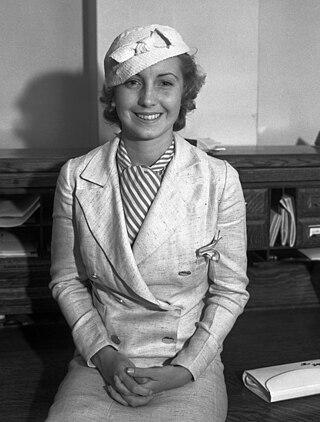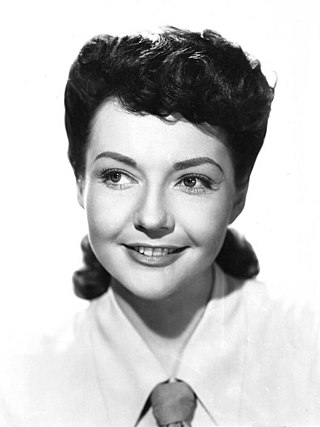Related Research Articles

Jane Wyman was an American actress. She received an Academy Award (1948), four Golden Globe Awards and nominations for two Primetime Emmy Awards.

Martha Tilton was an American popular singer during America's swing era and traditional pop period. She is best known for her 1939 recording of "And the Angels Sing" with Benny Goodman.

Rhonda Fleming was an American film and television actress and singer. She acted in more than 40 films, mostly in the 1940s and 1950s, and became renowned as one of the most glamorous actresses of her day, nicknamed the "Queen of Technicolor" because she photographed so well in that medium.

Herbert Vigran was an American character actor in Hollywood from the 1930s to the 1980s. Over his 50-year career, he made over 350 television and film appearances.

Lynn Bari was an American film actress who specialized in playing sultry, statuesque man-killers in roughly 150 films for 20th Century Fox, from the early 1930s through the 1940s.

Connie Russell was an American singer and movie actress. Born in New York City, she appeared in seven films from the 1930s through the 1950s. She was far better known as a singer than as an actress, as her singing career was quite extensive.

Ilona Massey was a Hungarian-American film, stage and radio performer.
"Just One of Those Things" is a popular song written by Cole Porter for the 1935 musical Jubilee.

Lurene Tuttle was an American actress and acting coach, who made the transition from vaudeville to radio, and later to films and television. Her most enduring impact was as one of network radio's more versatile actresses. Often appearing in 15 shows per week, comedies, dramas, thrillers, soap operas, and crime dramas, she became known as the "First Lady of Radio".

Elliott Lewis was an American actor, writer, producer, and director who worked in radio and television during the 20th century. He was known for his ability to work in these capacities across all genres during the golden age of radio, which earned him the nickname "Mr. Radio". Later in life, he wrote a series of detective novels.
Steve Gravers was an American character actor who appeared in numerous television shows and several films in a career that lasted from 1952 until his death in 1978.
Steve Randall is an American detective television series starring Melvyn Douglas. The series' 13 episodes were initially seen in syndication during the summer of 1952, before being picked up and rerun by the DuMont Television Network from November 7, 1952, to January 30, 1953. CBS subsequently ran 9 of the same 13 episodes again from June 16, 1953, to August 11, 1953.
Crime with Father is an early American police drama that aired on ABC on Friday nights from August 31, 1951, to January 18, 1952.
Detectives's Wife is an American television sitcom that aired on CBS from July 7 to September 29, 1950. The series was the summer replacement for Man Against Crime.

Curt Massey was a musician in the old-time radio era.

Biff Baker, U.S.A. is an American adventure television program starring Alan Hale Jr. in the title role and Randy Stuart as his wife, Louise. The series was broadcast on CBS from November 13, 1952, until March 26, 1953. After the show's network run ended, it was syndicated, with reruns being broadcast until late in the 1950s. Lucky Strike cigarettes sponsored the program.
Hollywood Opening Night is an American anthology television program that was broadcast on CBS in 1951-1952 and on NBC in 1952-1953. The NBC version was the first dramatic anthology presented live from the West Coast. Episodes were 30 minutes long.
The RCA Victor Show is a 1950s American television program broadcast on NBC that eventually became The Dennis Day Show. It began on November 23, 1951, and ended on August 2, 1954.
Janet Dean, Registered Nurse is an American medical drama television series. It was released in February 1954, and it continued to be broadcast in reruns in the early 1960s. It was the first TV series in which the lead was a nurse. By October 1954, the show's title had been changed to The Ella Raines Show "following the lead of other packages that switched to the stars' names to help pull an audience for the package."
Sheena, Queen of the Jungle is a syndicated American television adventure series that was broadcast in 1956-1957. The title character was "the female counterpart of Tarzan."
References
- 1 2 3 Romanko, Karen A. (2016-03-01). Television's Female Spies and Crimefighters: 600 Characters and Shows, 1950s to the Present. McFarland. p. 175. ISBN 978-1-4766-2415-0 . Retrieved May 18, 2021.
- 1 2 3 4 Brooks, Tim; Marsh, Earle (1999). The Complete Directory to Prime Time Network and Cable TV Shows 1946-Present (7th ed.). New York: The Ballentine Publishing Group. p. 850. ISBN 0-345-42923-0.
- ↑ McNeil, Alex (1996). Total Television (4th ed.). New York, New York: Penguin Books USA, Inc. p. 691. ISBN 0-14-02-4916-8.
- ↑ Adams, Val (February 24, 1952). "That's why the lady is a vamp". The New York Times. p. X 11. Retrieved May 18, 2021.
- 1 2 Morse, Leon (February 23, 1952). "Rendezvous" (PDF). Billboard. p. 13. Retrieved May 18, 2021.
- ↑ Crosby, John (March 8, 1952). "Criminal Careers Cut Short by Eyelashes". Star Tribune. p. 21. Retrieved May 18, 2021– via Newspapers.com.